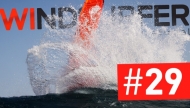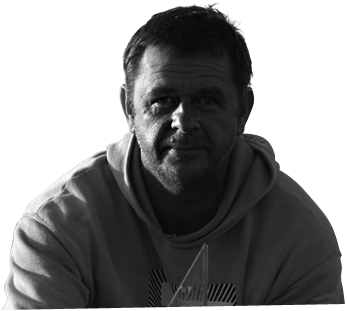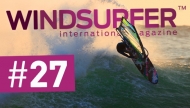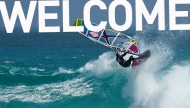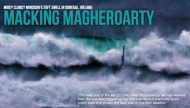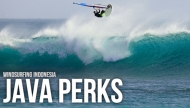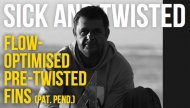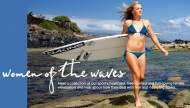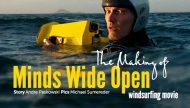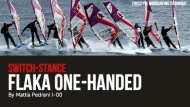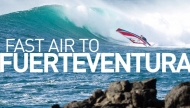No stranger to innovation, Bouke Bekker of Witchcraft Sailboards has championed TriFin and Thruster setups on wave boards for some years now - he reckons you get less flow interruption than with the closer spacings of Quads - and has now developed a new twisted fin system that could even set the surfing world on fire, let alone its capabilities for wavesailing. As our sails incorporate twist for efficiency – as do propellers – could a varying profile cause more lift than drag?Bouke explains himself:
Now that most brands have rolled-out multi-fin wave boards, there is no doubt anymore they are here to stay. But just how do these fins work? The main reason that they are better for wave boards is simple physics: Shorter fins (less leverage) with more area.
Path of Least Resistance
No matter what fins and how you put them, that fact alone will already give an advantage.
But there is more to it to get the most out of a MultiFin set up. In 2004-5 I started experimenting with toe-in
(see glossary) through the
Four Way Fin System (4WFS), that lets you adjust the toe-in, and quickly came to the conclusion that a certain amount of toe-in makes the board to turn better but also faster.
The reason behind it is quite logical: A planing board pushes the water down and the water wants to escape this pressure in the shortest route, which is towards the rails. So, rather than flowing straight from front-to-back, the water is deflected sideways at an angle. As happens with any vessel really, it’s just less obvious with windsurf boards.
These findings and the explanations behind them were published in an article in 2007 in Boards magazine. But already then I realised this was not the end of it and that the toe-in angles we found working best were just an average and that the optimal toe angle would probably vary over the depth of the fin. Because the water flow deflection would be biggest directly under the board, where the highest pressure is created by the planing hull, although this effect would most likely disappear as you get deeper and further away from the board underwater.
How Deep is Your Flow?
Anyone can imagine that at 1m depth, it will have disappeared. But how much exactly? Busy with other developments, this kept lingering in the back of my head for a few years trying to find a solution to continue with research on this field. Then, in 2010 I had a Dutch engineering student on an internship to help me with fin development. Daniel prepared himself well and used a sophisticated Computer Fluid Dynamics (CFD) software program to simulate water flows. This was better than I could’ve imagined.
The program allowed us now to ‘see and ‘feel’ under water. You could put the board and fins in any angle in a waterflow and see the flow and calculate drag and lift of each fin. Soon we discovered how much the sideways flow deflection actually reduced over the depth of the fin. According to this, the fin shape should change over the depth by pre-twisting it so that the Angle of Attack (AofA) would be the same at any depth.
Angle Management
Following this we designed some pre-twisted fins. This may sound weird, but if we look around us, this is far less strange than it may seem. We see examples everywhere: aeroplane and ship propellers, fans and - especially for us - windsurf sails. All of these have twist to optimise the AofA over the whole length of the foil. Maybe you can imagine how heavy and draggy a sail without twist would feel? The difficulty in this case was not the solution but the recognition of the problem. For an engineer it´s easy to make out the AofAs for a propeller or sail – but under a moving board with a fin being of much smaller scale - it´s not that easy.
Whereas it would seem impossible to simulate a wave riding board on a wave, you can simulate some standard situations that important in wave sailing, such as going upwind, down-the-line ( with less sail pressure – more surfing motion), and making a turn with the board banked over on a rail. We did hundreds of simulations going through all the variables; angles of attack, toe-in angles, foils etc. and compared the results in graphs gaining an enormous amount of information.
Glossary:
Toe-in: Angle of an off centre placed fin with the centre line of the board
Cant: or
Splay:Angle of the fin perpendicular with the bottom.
AoA: Angle at which the water hits the fin.
4WFS: 4-Way Fin System
www.4WFS.com
Grip: Ability to hold a turn without breaking out.
Drive: Feeling of acceleration through a turn
NACA Profile: Profiles developed by NASA for various purposes.
National Advisory Committee for Aeronautics.
Flex: Bending of the fin.
Twist: bending of the fin with the water flow to prevent a too much AoA, drag and loss of grip.
RTM: Resin Transfer Molding. A manufacturing method using moulds where the fibres are placed around a foam core, the mould is closed and then resin is transferred into the mould.
DTL Down the Line

